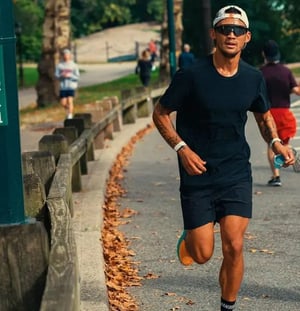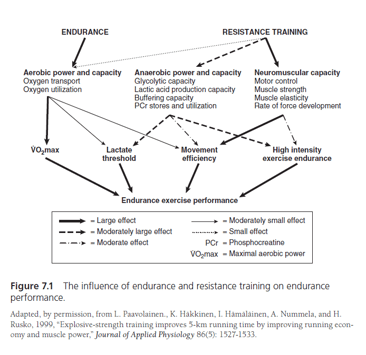Inside My Body When I Run: Ep. 1 Find a Baseline to Tap into the Benefits of Running
August 30, 2022
Taking up running is somehow all at once empowering, inspiring, and mentally stabilizing...while also being body-confusing, joint-aching, and fuel-depleting. It's the conundrum that every new runner comes across. It's so easy to lace up and go, but so difficult to answer these burning questions that enter every runner's head:
- How far do I run? I think I want to do a marathon, but am I ready?
- What am I wearing? (Shoes, clothing, gear, smart devices)
- When do I eat? What is a "goo" anyway?
- How fast can I go? How do I get faster?
- What the hell do I do with my arms?
In this 5-part blog series, we'll talk about the inside-of-your-body factors that will help you decide what's best for you when you run. In our experience as Physical Therapists, runners who are aware of these concepts can understand themselves as athletes and actively engage with becoming better runners. Training can be a learning experience that helps you avoid injury by making good decisions and gets you racing faster from season to season.
FIND YOUR WHY
There are so many different reasons that people take up running. We tapped our community to see how, and why, different types of people take up the sport for different reasons.

|

|
| JP Lemire (MOTIVNY Coach - Half-marathon -> Marathon) - It helps me find answers as a coach and as a person; there's always something more to digest. Running helps me find myself in that process. | Emily Abbate (Hurdle Podcast - Marathons) - I run because it reminds me of my own power; how capable I am to handle hard things. |

|

|
| Frances Callaghan (Tech Professional - 70.3 triathlon) - Running can be a place to process thoughts or escape thoughts...Whatever you need at that moment. For me the endorphins effect is real. I feel my energy and mood elevating. | Francisco Balagtas (MOTIVNY Run coach, pizza enthusiast, No Days Off - Marathon, Ultra-marathon) - Presently...acknowledging that my why has changed over the years...running is a source of normalcy. It's hard to imagine life without running, so I do it every day to keep in touch with my normal. |

|

|
| Kristina Centenari (Strength Coach @ Tonal - 70.3 triathlon -> Marathon) - I run because it's a constant reminder of how strong and capable I am, yet there is still infinite room to grow and get better | Ayca Acun (Senior Creative Director @ Nike - Wellness/mindset running) - I run because its a part of my fitness journey/routine, but most importantly, it's very therapeutic, helps me solve problems organically, and feel free. |
Hopefully hearing some of the MOTIVNY running community's "why" will help you find yours. It's important to start trying to figure this out as soon as possible. Without your "why", it's difficult to know whether the volume, frequency, and intensity of your training are matching your goals.
I'll offer some categories where "why" might fit, but it's up to you to personally identify your reasons.
- Mental Health
- Identity Exploration
- Sports Performance (running, or other sports)
- General Physical Wellness
- Competitive Spirit
- Community Engagement/Friends
- Any other why that you choose!
LEARN WHERE YOU'RE STARTING FROM
When it comes down to it, runners go out for many different reasons, but most of us will take up training in order to improve our performance, reach our goals, or find more purpose in being out running. Once you've decided to take up a training program, it's essential to evaluate yourself for your current capabilities so that you can set realistic goals, and choose the training program accordingly. In my experience with injured athletes, this is where people go wrong far more frequently than anywhere else.
I'd love for all runners to pause for a moment and read (and re-read!) the following statement:
When you go out for a training session, whether running or cross-training, you are seeking physiological adaptation. If you aren't making adaptations in your body, the training is WRONG for your goals.
Most readers probably aren't physiology experts, so here's a brief introduction to some of those concepts and how they potentially fit into different running experiences. See the chart below for reference:

There are a lot of different types of athletes. We've outlined a few lifestyle categories that might apply to where you're starting from as you begin your running journey, and to help you understand the chart above.
WHAT KIND OF ATHLETE AM I?
The never-before runner/athlete
It's tough out there getting started, but you got this! With not much experience in your athletic background, your body is less likely to have a large tank in Aerobic Capacity (VO2 Max). That means you'll need to spend a larger amount of time base-building. We recommended keeping 60-70 percent of your training in your Zone 2 heart rates and intensities (More on this in future parts of the series). Yes, this may mean you start out run-walking... that's okay! Mixing in resistance training is also very important to help build your body's ability to use energy efficiently and enhance motor control (READ: skill and technique). Be patient with yourself, and set modest goals for your first season out. Longer distance events will be more challenging and require a better base. Those things can definitely be tempting, but it's probably best not to tackle marathons or Ironman events straight away. You'll have plenty of time to grow into those events.
The childhood ex-athlete
If you were a serious high school or college athlete in other sports, you probably have a pretty good athletic base to awaken somewhere in your body. Athletes such as soccer players, football, lacrosse, swimming, and other sports will likely have a better base on the resistance training side of the chart. Those sports have taught your body about movement efficiency and power development; now it's time to wake up those skills and apply them to running. Especially if you've taken time away from those sports, you may take for granted the value of building your aerobic base and increasing your movement economy. If you feel like you've acquired stiffness in your body from those sports, or from some number of years behind a desk, make sure you keep focused on moving WELL and not just running FAST. Your body will make better adaptations that way.
The "I used to run, but not recently"
You checked out cross-country in high school or college, and maybe you even ran half-marathons or marathons before, but it's been a while (3+ years). Your body probably held onto a decent amount of that aerobic capacity, but it will take some time to re-train to previous levels. Not as long as the novice runner, but don't skip that part of the process. One thing we know about runners: they love to run...and they love to do other stuff less (resistance training). If this sounds like you, know that you'll be even faster if you build your program with 1-2 strength training sessions a week, and don't skimp on your plyometrics and explosiveness. Think of it as building up the horsepower of your muscles so that they have the power to run at faster paces. Distance running isn't where these changes are made. Hit the gym!
The "I've been running for a while, but not too seriously"
You're the kind of athlete who has run 2-3 days a week for the last few years, but never really with much structure. Maybe you sign up for a race here and there, but the paces never really change and it's more about the social aspects. That's all great, but now you've decided it's time to up your game. You've likely never pushed yourself hard enough to build your Aerobic Capacity to its fullest and could use some resistance training to build your power and make those sessions easier. Start with one session of interval training.
Recommended workout: 3-5 minutes on at a 7/10 effort followed by enough rest to recover your heart rate; next, repeat that for 5 rounds. Run through that workout once or twice a week on the track, a bike, or a rower. This is great supplement to the steady running that you've already been doing.
The currently competitive athlete
You're the athlete that really needs to lock in on programming and physiology. You know what your body is already capable of, so it's time to make the program structured to push you to the next level. You've got a solid capability in running, but you'll need to push tempo runs to adopt higher levels of Lactate Threshold, mitochondrial density, and quite frankly, to just learn how to move your limbs even faster. Focus more on your effort level and how you feel when you run than on the paces. You will benefit most from objective testing, such as VO2 max or lactate threshold testing to know your performance levels with certainty.
THE PATH AHEAD
Now that you know more about what pieces are involved in endurance performance, and started to think about WHO YOU ARE and WHY YOU RUN, it's time to learn more about the specifics.
Look for the upcoming parts of this series to learn about:
- What is VO2 max and how does breathing enhance running performance?
- How to learn how to be a better runner. Skill, speed, performance.
- Metabolism: What does it mean and how do I make sure my body has the right fueling?
- Strength training and muscle building as part of a comprehensive running program.
- Programming and action planning for your events.
Our goal is for this series to expose you to the scientific aspects of running for you to nerd out on, but to also give you some distilled concise takeaways that all athletes can put into action.
Happy running.

LUKE GREENBERG
Manual Medicine, Kettlebells and Golf Training, Team Dad
